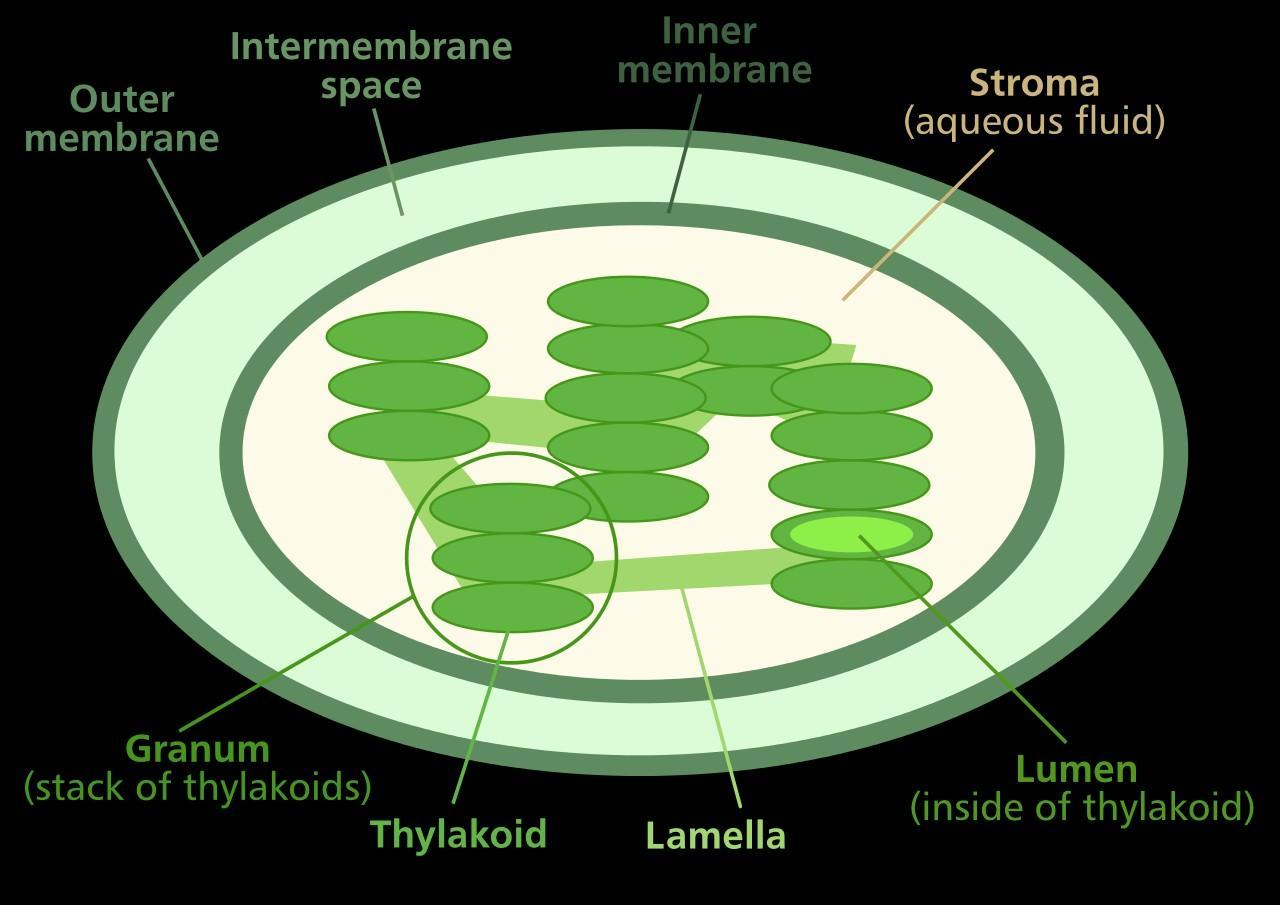
Chlorophyll is present
A. In the grana of chloroplast
B. On the surface of chloroplast
C. Dispersed throughout the chloroplast
D. In the stroma of the chloroplast
Answer
501k+ views
Hint: Chlorophyll is present in the inner membrane of an organelle which is also known as “baggy trousers”. The name of the organelle was coined by a scientist known as Menke.
Complete answer
The chlorophyll molecules are present on the inner side of a double membraned sac-like organelle known as thylakoids. 3-100 thylakoids are stacked together to form a structure known as grana. The inner surface of the thylakoid membrane has quantasomes which are the actual functional units of photosynthesis. These quantasomes are composed of 230 chlorophyll molecules.
Additional Information:
Chloroplast has the following feature:
-The chloroplast contains three parts: the envelope, stroma, and the lamellar system.
-It is also known as the autoplast and the photosynthetic apparatus.
Envelope: The envelope is a double membrane structure, the outer membrane is freely permeable but the inner membrane has shown selective permeability.
Stroma or Matrix: Proteinaceous and consists of double-stranded circular DNA known as plastidome. The enzyme RUBISCO, which is also the most abundant enzyme on earth, is present in the stroma of the chloroplast.
Lamellar System: It consists of thylakoids. Thylakoids are considered as the structural units of the chloroplast In-plant cells each chloroplast has a total of 40-60 grana but these are absent in the chloroplast of algae and bundle sheath cells of C4 plants.
-The inner membrane contains light-harvesting units known as quantasomes. These structures take part in photosynthetic reactions.
So, the correct answer is, “Chlorophyll is present in the grana of the chloroplast.”

Note:
Chloroplasts are known as Semi-autonomous cell organelles because they have the following two features:
-They possess their own DNA, RNA, and ribosomes.
-They also possess their protein-synthesizing machinery.
A chloroplast can be of a variety of shapes. In Chlamydomonas it is cup-shaped, in ulothrix it is girdle shaped, the spiral-shaped chloroplast is seen in spirogyra, and discoidal chloroplast is seen in higher plants. In quantasome, out of the 230 chlorophyll molecules, 160 are chlorophyll-a molecules and 70 are chlorophyll-b molecules.
Complete answer
The chlorophyll molecules are present on the inner side of a double membraned sac-like organelle known as thylakoids. 3-100 thylakoids are stacked together to form a structure known as grana. The inner surface of the thylakoid membrane has quantasomes which are the actual functional units of photosynthesis. These quantasomes are composed of 230 chlorophyll molecules.
Additional Information:
Chloroplast has the following feature:
-The chloroplast contains three parts: the envelope, stroma, and the lamellar system.
-It is also known as the autoplast and the photosynthetic apparatus.
Envelope: The envelope is a double membrane structure, the outer membrane is freely permeable but the inner membrane has shown selective permeability.
Stroma or Matrix: Proteinaceous and consists of double-stranded circular DNA known as plastidome. The enzyme RUBISCO, which is also the most abundant enzyme on earth, is present in the stroma of the chloroplast.
Lamellar System: It consists of thylakoids. Thylakoids are considered as the structural units of the chloroplast In-plant cells each chloroplast has a total of 40-60 grana but these are absent in the chloroplast of algae and bundle sheath cells of C4 plants.
-The inner membrane contains light-harvesting units known as quantasomes. These structures take part in photosynthetic reactions.
So, the correct answer is, “Chlorophyll is present in the grana of the chloroplast.”

Note:
Chloroplasts are known as Semi-autonomous cell organelles because they have the following two features:
-They possess their own DNA, RNA, and ribosomes.
-They also possess their protein-synthesizing machinery.
A chloroplast can be of a variety of shapes. In Chlamydomonas it is cup-shaped, in ulothrix it is girdle shaped, the spiral-shaped chloroplast is seen in spirogyra, and discoidal chloroplast is seen in higher plants. In quantasome, out of the 230 chlorophyll molecules, 160 are chlorophyll-a molecules and 70 are chlorophyll-b molecules.
Recently Updated Pages
The correct geometry and hybridization for XeF4 are class 11 chemistry CBSE

Water softening by Clarks process uses ACalcium bicarbonate class 11 chemistry CBSE

With reference to graphite and diamond which of the class 11 chemistry CBSE

A certain household has consumed 250 units of energy class 11 physics CBSE

The lightest metal known is A beryllium B lithium C class 11 chemistry CBSE

What is the formula mass of the iodine molecule class 11 chemistry CBSE

Trending doubts
State the laws of reflection of light

One Metric ton is equal to kg A 10000 B 1000 C 100 class 11 physics CBSE

Difference Between Prokaryotic Cells and Eukaryotic Cells

How do I convert ms to kmh Give an example class 11 physics CBSE

Describe the effects of the Second World War class 11 social science CBSE

Which of the following methods is suitable for preventing class 11 chemistry CBSE




